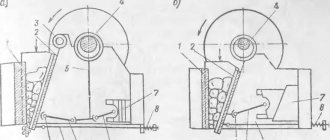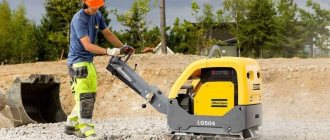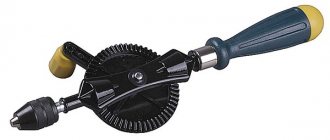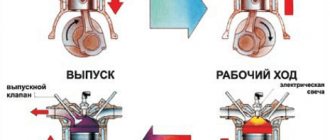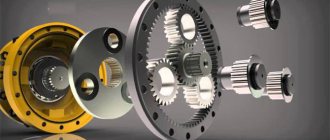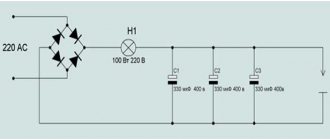A jaw crusher is a universal type of equipment designed for crushing rocks, metallurgical slags, and other solid materials. It allows you to grind large pieces of feed material 4 times (for example, from a particle size of 800 mm to a size of 200 mm).
The crusher got its name because of the main working elements - “cheeks”. One of them is in a fixed position, the second moves in a reciprocating direction. Working surfaces can be smooth or ribbed. “Cheeks” of the first type are used for brittle materials and fine grinding. Ribbed surfaces are used for hard materials and coarse crushing. By changing the gap between the “cheeks”, you can adjust the size of the pieces at the exit to a specified value.
Areas of application
The jaw crusher crushes large pieces of solid material into smaller pieces and is in demand as a primary machine everywhere. Most often, such equipment is used for crushing non-metallic minerals (stone and crushed stone). Main applications of jaw crushers:
- for coarse (1500–350 mm) and medium (350–100 mm) crushing of ore and non-metallic minerals (shale, coal, iron ore, non-ferrous metal ores, granites, basalts, gabbro, etc.);
- In the construction industry for grinding bricks, slag, hardened concrete, ceramic and some metal materials.
Jaw crushers are the main technological equipment of beneficiation production. Electricity consumption is 0.3–3 kWh per ton of crushed material.
We answer questions
How much can a stone crusher cost for a summer cottage?
The cost of crushers varies widely, depending on their type and performance. A household model of the jaw or cone type will cost $200-1500.
What is the best type of stone crusher for limestone and chalk?
Rotary and roller crushers are well suited for rough grinding of these rocks; for fine grinding (production of a powder product), milling equipment can be used.
Can a jaw crusher crush granite?
Household - hardly. But jaw-type industrial equipment can easily cope with such a task.
How to repair knives on drums?
If we are talking about the beaters of rotary crushers, it is easier to replace them; if we are talking about the teeth of roller machines, you can try to align them and sharpen them using a metal file.
Is it possible to make a crusher with your own hands?
Yes, but it is not suitable for crushing stones unless you have the skills of a professional lathe, miller and welder. At home, you can make a crusher for soft lumps of substances, branches, food products - video instructions are attached.
Design
Despite the variety of design features, most jaw crushers use designs that were developed more than a hundred years ago.
The main regulatory document relevant for this equipment is the interstate standard that is still in force, adopted in 1993 - GOST 27412-93. The standard jaw crusher model includes the following main components:
- Bed . It is a cast base on which all other parts and mechanisms are installed. The frame has a reinforced design and significant weight, since the safety of the crusher depends on its stability and reliability.
- Crushing chamber. It is formed by two crushing plates (cheeks) and has a wedge shape. One of the surfaces is fixedly fixed, the second is placed on the connecting rod and together with it carries out a reciprocating (swinging) movement in the vertical direction. The movable “cheek” is designed so that it is possible to adjust the position of its lower edge in the horizontal plane and set the maximum size of crushed pieces at the exit.
- Eccentric shaft . Transfers energy from the power drive to the movable “cheek” and converts rotational motion into reciprocating motion. The main shaft contains a connecting rod, a pulley and a flywheel.
- Drive unit . It includes an electric motor and a drive pulley connected to it through a coupling, which is fixed to the shaft and transmits torque to the driven one.
- Control system . Ensures the execution of all basic commands: step start, emergency shutdown, activation of protective relays (during overload, overheating, etc.), operation of a pre-start alarm, and more.
Principle of operation
The crushing process with jaw crushers includes the following sequential steps.
- Loading of raw materials . Large pieces of material are poured into the crushing chamber from above. The latter has a wedge-shaped shape, which facilitates the primary sorting of raw materials by size. Larger pieces are placed at the top, smaller pieces at the bottom.
- Splitting up . The movable “cheek” moves closer to the fixed one, exerting pressure on the backfilled material. In the process of bringing the working surfaces closer together, it is crushed into smaller fractions. When the “cheeks” diverge, the crushed material moves downwards under the influence of its own weight. If the pieces are smaller than the outlet, they leave the crushing chamber.
- Elimination of metallic inclusions . Not all crushers have this feature. It is required in processing plants or in those industries where the absence of metal in the final material is fundamentally important. Ferrous metal inclusions are captured using magnets.
- Unloading . Pieces of material, crushed to a specified size, exit the crushing chamber. High-performance models are equipped with high-speed belt conveyors, which significantly speed up unloading.
For crushing high-strength rocks, it is recommended to use models in which both “cheeks” are movable.
Choosing a device for home and professional use
When choosing a specific stone crusher model, it is important to know not only the required productivity and the nuances of the granulometry of the equipment, but also to navigate the physical properties of the materials with which you will have to work.
First of all, we are talking about hardness and abrasiveness indicators. Knowing these properties, as well as the budget for purchasing equipment, you can decide on the required type of working parts.
Then they start choosing the chassis. If the stone crusher will be installed directly at the site of production of finished goods or semi-finished products from lump raw materials, it is better to give preference to stationary models; in all other cases, it is worth purchasing towed crushers. The use of self-propelled devices is justified only in the mining industry, when the hourly productivity of work is estimated at tens of tons.
Requirements for jaw crushers
Construction . It must be such as to ensure round-the-clock operation, including stops for routine inspection and maintenance, as well as safe access to places of adjustment, lubrication and replacement of wearing parts. In addition, the following must be provided:
- protection against breakage when an indestructible element enters the chamber;
- protection of lubricated friction pairs from dust;
- no upper ejection of pieces from the crushing chamber;
- both local and remote control.
Materials . The “cheeks” are the most subject to wear, so they are made of wear-resistant alloys. The type of metal is selected in accordance with the rock being crushed. For crushing hard materials, “cheeks” made of steel alloyed with chromium or manganese are used; for soft materials, “cheeks” are made of half-bleached cast iron.
Pros and cons of jaw crushers
Advantages . These include the following:
- high wear resistance of working elements (“cheeks”);
- small dimensions for easy transportation and installation;
- accuracy of output size adjustment;
- stable operation under intensive round-the-clock load;
- simple maintenance and easy replacement of worn parts.
Flaws . They are related to the design and operation features of crushers, and are as follows:
- impossibility of use for working with elastic materials - wood, plastics, some alloys;
- significant vibrations, requiring a very solid foundation and not allowing installation on upper floors;
- unsuitability for working with flagstone rocks (easily divided into plates).
Rotary
The operating principle of an impact crusher is based on the rotation of a rotor equipped with steel blades (beaters) inside a tapering annular chamber. The blades, colliding with stones, either immediately crush them or throw them onto the impact surface.
Each particle hits different surfaces multiple times at different accelerations, resulting in uniform, although not too rapid, fragmentation.
The main area of application of rotary crushers is the procurement of construction raw materials of low hardness. With their help, you can obtain a high-quality and uniform product. The main disadvantage of this design is the low durability of the beaters.
Types of jaw crushers
The main parameter for the classification of equipment is the nature of the movement of the main working body - the “cheek”. It defines the most important technical and operational characteristics of jaw crushers and divides them into two groups.
With simple movement (SHDP) . The “cheek” moves along a circular arc. Shredding of lump material is carried out by crushing. The advantages of such models include less wear of crushing surfaces and the ability to work with high-strength rocks. The disadvantages are higher metal consumption and unevenness of the final material compared to the second group of crushers.
With complex movement (SCDS) . The movable cheek moves along a closed curved path, most often along an ellipse. The equipment crushes the material by both crushing and abrasion. Such crushers have more compact dimensions and are used to work with relatively small ores with a low content of abrasive substances and a high content of moisture and clay. They are not used for coarse crushing.
Roller
Roller stone crushers combine pressure loads with cutting loads. The multidirectional movement of their drums, equipped with sharp teeth, pulls the primary material inside, where it is subjected to strong compression and axial abrasion, as well as multiple impacts on the cutting edges.
Due to their low cost, open design, ease of maintenance and repair, roller crushers are very popular in small industries. They are quite effective and provide high product homogeneity, but are prone to rapid wear.
In some cases, the area of the teeth is increased, and their edges are not sharpened. This reduces the productivity of the crusher, but increases its resource and makes it possible to work with more durable rocks and substances.
Kinematic diagrams of jaw crushers
1 a. In simple motion crushers (SMMC), the working surface - “cheek” (1) is suspended on an axis (2) and moves along a circular arc. The motion impulse is transmitted through the shaft (3), connecting rod (4) and spacer plates (5). Grinding is carried out by crushing, as well as (partially) breaking and splitting due to the presence of longitudinal corrugations on the crushing surfaces.
1 b . ShchDS crushers (with a complex trajectory of movement) have a simpler kinematic diagram. The shaft (3) is directly connected to the connecting rod, which is also a movable “cheek” (1). The latter rests with its lower end on the spacer plate. This design provides a complex ellipse-like motion path and enables grinding by crushing and grinding. This allows the use of ShchDS crushers for working with viscous materials.
Comparison . At the same rotational moments, higher loads on the material are created on the SHDP crushers, which makes it possible to crush larger and stronger pieces. ShchDS equipment cannot be used for such crushing, but its design is more simple and less metal intensive. The mechanism of movement of the “cheek” can be lever, cam or hydraulic transmission. The latter is shown in Figure 1c.
Types of stone crushers
The first of the necessary machines is a jaw stone crusher . It gives a large fraction. However, in any stone crusher there is a yield of several fractions. Simply, one of them is the main one. It is selected when the stone is passed through a sieve. The fraction depends on the size of its cells.
The cheek apparatus is made of two steel planes. They crush the rock. The working space between the “cheeks” of the device is wedge-shaped. In most machines, one of the crushing planes is stationary. But, there are devices with 2 active “cheeks”.
When crushing with jaws, the crushed stone is removed by moving the steel presses to the sides. Grinding occurs when the planes approach each other. They will bend some pieces of rock, grind some, and crush some.
There are 2 more crushers on the list that crush stone. These are cone and roller machines. The two shafts of the latter move towards each other. The rock is pulled into the gap between the aggregates. Their surface can be smooth or spiked.
The photo shows a jaw stone crusher
The latter option is more productive and produces a finer grind. It comes out from the bottom of the device. Consequently, “bowls” are left under the roller crushers for the crushed material. In a cone unit, the rock is pressed with a metal press.
It is shaped like a cone, hence the name of the machine. The press is lowered into a rotating “glass”, while rotating in the opposite direction. The stone is loaded into the lower container and pressed and crushed.
The conical bowls of cone crushers are stationary. This reduces the efficiency of the machines. The crushed stone is poured through a pipe into a “bowl” when the press is removed from it. A cone stone crusher is more productive and economical than a jaw or roll crusher. Small dimensions and a simpler device “speak” in favor of the latter. The more complex the circuit of the unit, the less reliable it is. Accordingly, cone crushers break down more often.
Two of the remaining types of rock crushing apparatus are impact crushers. They all have hammers. Let's start with a rotary machine. It specializes in soft or, on the contrary, materials of increased strength.
The photo shows a cone stone crusher
The devices have a 1-inch powerful rotating rotor with hammers attached to it. The rock is served on top. The simplicity of the design makes the devices reliable, and they also have high performance.
The disadvantage of impact crushers is the rapid wear of the hammers. You have to buy new ones and replace them. In addition, buying or renting a rotary stone crusher does not allow you to sift out large particles from crushed stone. The fraction turns out to be heterogeneous.
The problem of impact wear is minimized in hammer stone crushers. The industrial version is used for grinding brittle materials. Enterprises working with salt, gypsum, limestone, chalk, coal and asbestos are eager to acquire a hammer crusher. They differ from rotary machines by the hinged mounting of the impact elements.
This is what reduces their wear. In addition, hammer crushers are compact and allow you to control the grinding by adjusting the diameter of the hole for loading the stone. It remains to mention centrifugal crushers. In them, the impact mechanism is supplemented with an accelerator. The rock begins to circle around its axis. Centrifugal force works. She throws stones at the reflective plate.
Scheme of operation of a cone stone crusher
The higher the impact speed of the rock, the smaller particles it scatters. This is how the crushing fraction is regulated. Centrifugal rock grinding devices are the most economical; compared to other devices, they consume approximately 30% less energy.
